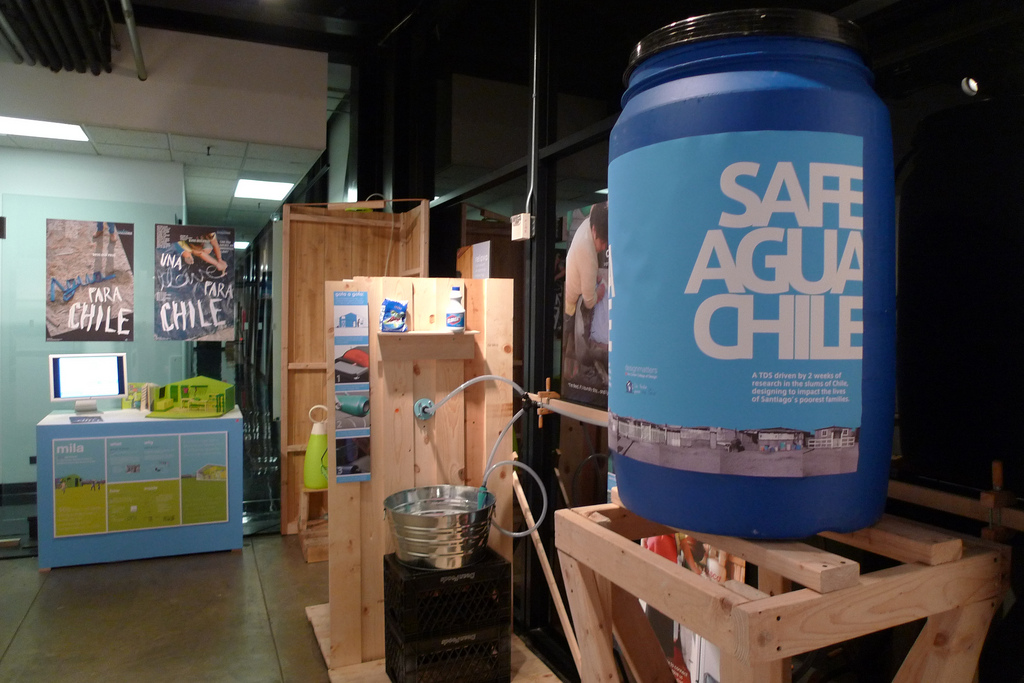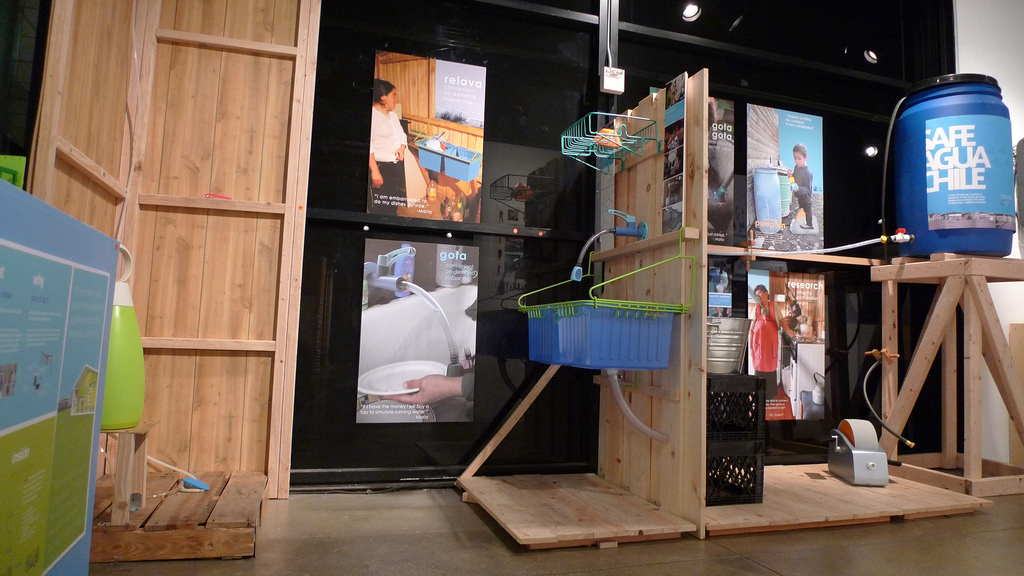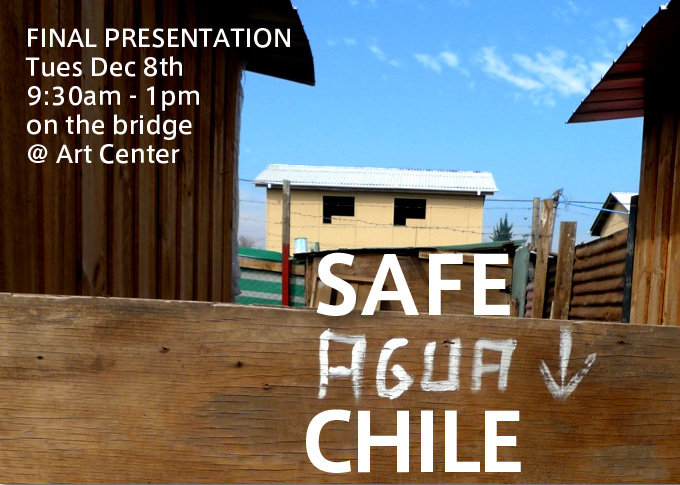
Please come visit — the project will be on display from December 12, 2009 – mid April 2010.
Art Center College of Design Gallery 1700 Lida St Pasadena, CA 91103
Great job everyone, and a huge GRACIAS for all your hard work, passion & commitment — we are so proud!



It was apparent early on in our research that laundry was one of the key problems facing the community in the campamentos- so I am excited about taking it on. I am thankful to my classmates and outside resources that helped me to develop my proposal for mid-term. The amazing insights into the problems with laundry that were expressed by each team spurred me forward and I was able to gather and analyze my own findings with the collective research to help find my project direction. Since the general topic of laundry came attached to numerous problems I narrowed my scope to focus on time and injury related to laundry. Even though, my scope focused on two very specific problems I found that by doing so my project became richer, and in a wonderful way created the opportunity to make an even larger impact on the community.
Problem Laundry takes a long time and causes injury


Solution A common laundry facility or Lavandería.

The shared laundry facility would save money, increase access to washers and dryers, save time, build relationships and encourage personal growth. A great benifit of a shared laundry facility- besides addressing the time and injuries associated with washing, is the opportunity to build community relationships. The shared space also has the potential to become an important collaborative space for the community- housing classes, computers, gatherings, community boards, childrens space, etc…
As I contiune to explore the possibilites for a community space/lavandería, I also hope to learn from/implement some of the projects from my fellow students, build off of some existing frameworks set up by UnTecho and work with the families in the campamentos and casa definitiva to create the most effective and impact-full laundry/community space I can.
-Stephanie
Hi everyone,
This is just a quick update to let you know that, following our midterm critique, KC and I are changing our mission statement. After learning that most people in the campamentos do not necessarily get their water shut off because of excessive water use, we decided it didn’t make sense to pursue our direction of helping people transition out of the campamentos by reusing water. Instead, we are now focusing our efforts on the task of dishwashing, designing new solutions to make it more dignified and efficient. We got great feedback from Rosita on our first round of concepts and we’ll keep you all posted as they continue to develop.
Gracias!
Jackie

Problem: People in the campamentos have the ambition to create innovations with the materials and tools available to them, but do not have the resources and exposure of ideas for them to reference.

Solution: Create an information hub of innovations for the people of the campamentos. A constantly updated index of innovations that are separated by tasks like water, storage, shower, kitchen, etc. The innovations would be gathered from all the campamentos in Chile and would be displayed in an analog form such as a monthly newsprint, but would also have a web presence that would constantly be updated.
More updates from Innovation Station coming soon. Thanks.
Many Many Thanks to Techo for this amazing gift of hand ink drawings of favorite images taken by students in the campamentos during our research trip. We took a total of 5,000 photos in two weeks, and searching through them is no small feat. Askan, Julian & Andreas drew 100+ of these photos in a poster size present for the class. A M A Z I N G!!!!!
DesignMatters made a poster copy for each student and it is loads of fun to look through the drawings to recognize the people, places, and stories represented by the images…..
THANKS GUYS!!!!!!
Safe Agua Class -
Erica and I were challenged with addressing the issue of safe drinking and cooking water to prevent disease. Water treatment has been tackled in many different ways, by many different groups, but the challenge was in solving it in the context of the campamentos in Santiago, Chile. We found that existing solutions for subsistence conditions weren’t quite appropriate, as residents had access to municipal water. But high end solutions used in developed urban areas also didn’t fit due to a lack of infrastructure and running water. We had to design a water treatment product for people in the middle. People who have infrequent access to water and store it for several days at a time.
 We noticed in the campamentos that the containers used to store water were difficult to keep clean and often had wide mouths that increased the risk of contamination. How did the residents treat water that may have been contaminated en route to the mediagua or during storage? Either by boiling or adding chlorine, however these treatment methods are used infrequently, if at all. Boiling takes time and energy. Measuring chlorine accurately is difficult and inconvenient. People often poured chlorine into water without measuring. The taste of treated water is unpleasant. Erica and I sought to solve all of these problems with a series of products.
We noticed in the campamentos that the containers used to store water were difficult to keep clean and often had wide mouths that increased the risk of contamination. How did the residents treat water that may have been contaminated en route to the mediagua or during storage? Either by boiling or adding chlorine, however these treatment methods are used infrequently, if at all. Boiling takes time and energy. Measuring chlorine accurately is difficult and inconvenient. People often poured chlorine into water without measuring. The taste of treated water is unpleasant. Erica and I sought to solve all of these problems with a series of products.
A simple bucket retrofitted with a small cap for adding chlorine & water and a filter attached to a spout for dispensing water. The idea is that the bucket is easier to clean than a lot of their repurposed water containers and is small enough to store inside, preferably in the kitchen. Adding a small opening to the lid and base of the bucket and attaching a spout are easy and can be done by the individual.
An attachable cap that doubles as a measuring cup or tiny bags of premeasured amounts of chlorine. The idea here is to control the amount of chlorine added to water for increased accuracy in chlorinating water at the point-of-use. We focused on chlorine treatment, because chlorine is already apart of the residents daily cleaning routine, it’s fast, and with the attachable measuring cap that doubles as a lid or premeasured bag, accurate treatment can be easy.
And finally, a filter pack of activated carbon to insert at the base of the water spout. The idea is to remove chlorine byproducts as the chlorinated water passes through the filter and to the spout for drinking or cooking. Removing these byproducts improves the odor and taste, making the water taste good.
All of our ideas use readily available materials and are simple to assemble at home or could be purchased in a preassembled water treatment kit for a low cost.
Everyone should be able to take a warm shower. Benefits range from relieving stress and preventing illness to helping boast self esteem. Yet millions, if not billions of people go each day without a shower. In the Chile campamentos, most families resort to bathing by parts, which means they would fill up a bucket with preheated water, and use a cup sized container to rinse themselves. This process is time consuming, cumbersome, requires several containers to accomplish, and ultimately results in a cold shower that my lead to illness such as pneumonia.
This is why we found it so essential to address bathing as an issue and to find solutions to some of these problems. A key part in finding an appropriate solution is to narrow down the problems and see which are most crucial and which would make the biggest impact. At the top of our list was figuring out a way to eliminate cold showers and thus reduce the risk of illness. This does not necessarily mean we should find a better way of heating the bathe water, because the water that is retrieved from a kettle off the stove can reach boiling temperatures, which is in fact hotter then we’d like. The real problem is distribution of the hot water as well as consistency. This is where the idea of delivering a hot shower came in. We have the privilege of enjoying a hot shower. We turn a knob and instantly we are more relaxed, and for those few minutes, our worries go away. The people of the campamento deserve this opportunity, to have a warm shower on daily basis.
The key for resolving this issue was to find a proper way of pressurizing the water source, with minimal cost or effort. This meant using some sort of pump. We soon realized that the limitations of cost, were actually levels of investment. We could offer a variety of options at a variety of costs. This doesn’t mean the shower quality must suffer, but that the prep time may be different, and the steps involved may be different. In fact, it is ideal for us to establish a guarantee of shower quality just so that no one is penalized with an increased risk of illness because they are not able to afford a higher quality shower. If the shower quality did suffer because of the lowered price, then it what would be the point? we would not be solving anything at that point.
For the midterm we were able to present three levels of investment, ranging from $7 to $17, and each offered its own positive aspect. The first had the ability to adapt and be resourceful to its environment using the most minimal of new parts, and a handful of found objects. The second level offers the ability to be placed on a stove and heated directly before being moved to the shower location. This requires mostly new parts, yet is again sticking to bare minimum equipment. The third and highest level of investment uses all brand new parts, and offers a foot valve to control the water flow. This one can give a ten minute shower before requiring to be pumped again, but would require the water to be heated separately before being poured into the main reservoir.
The overall response from our audience was positive. They were impressed by the quality of the water flow from the shower. The mutual feeling was that the shower concepts we had proposed were great because they did not lessen the shower experience; that this experience was exactly how our showers experiences are (hot water, great flow, and a responsive on/off control). Our fears were that the system may be too large of an investment, but the guys from Un Techo Para Chile assured us that this was not the case, and that the investment levels were quite reasonable. There were some areas we were suggested to look at. These included the heading system, and mechanism. They asked that we try to make the distribution system and the heating system more unified, potentially eliminating the need to travel to the stove to retrieve hot water. Also, they asked that we take a look at the drainage system, and attempt to find a better way of draining the shower area.
As a group we feel quite confident that we are on the right track for midterm, and that our solutions are evolving at a great pace. We recognize the need to decide on how to introduce this solution to Chile and potentially the world as well as consider potential partners. While we are looking for the most complete solution, we also recognize the need to be able to offer options, because no two environments and no two users are alike. Thus, regardless of how great we can make a system, we need to make sure it is the right system for the lives of those that will be using it. We are looking forward to the next few weeks leading to the final design solution and business model. We feel that this project can drastically change the lives of millions around the world.
-JN
“I don’t like to do the dishes in front of the house because I don’t want people to see me.” –Maria
Washing dishes in the campamentos was another arduous task that people had to cope with on a daily basis. On this sunny winter day, the weather helped make this task a bit easier. But you can imagine how difficult it would be to do this chore outside during the winter. Wearing a heavy coat to wash dishes outside with cold water is reality for most families in the campamentos. I remember how cold my hands were not to mention the strong smell of Clorox when I finished helping her with the dishes.
Without the basic needs of running water and drainage, Maria used two plastic buckets on top of broken oven to soap and rinse her dishes. The steps to wash, required numerous carrying and moving of water to complete the task. I disliked washing dishes before I met Maria and still don’t like it but when I do clean, I’m constantly reminded of her family and what she has to endure daily.
![4056897879_393eb58916_b[1]](http://safewaterchile.files.wordpress.com/2009/10/4056897879_393eb58916_b12.jpg)
![4057637714_89d2637557_b[1]](http://safewaterchile.files.wordpress.com/2009/10/4057637714_89d2637557_b12.jpg)
Currently, my teammate Jackie and I are working on a formalized workstation for washing dishes to assist families like Maria. Here are some photos from our midterm presentation. We’ll keep you posted on our design direction. If you have any questions and/or comments please post!
Thanks!
Kc-
Our research trip to Chile was my first time south of the equator and my first time on a Sourthern continent. I was amazed at how friendly the people were. They were very warm, despite the chilly winter temperatures.
The day I flew into Santiago was the same day of our first visit to the campamentos. I was sick by the 4th day, so I didn’t see much of Chile, but what I did see was the friendliness of the people. The night of our first visit to the campamentos with Un Techo, I remember Laura’s husband greeted us, and of course, Rosita was really welcoming. Even though I had no idea who she was, she was open hearted and not embarrassed of what she had and very clear about what she wanted.
I had an allergy to something in the campamentos that made me sick. The casita we lived in was cold, too, making it worse. By the 4th night I was very sick and quarantined myself. I spent the night in a hotel.
By Friday, the fifth day, I went to the hospital by myself. I spent a half an hour trying to find the emergency room, because I don’t speak Spanish. Even though the nurses didn’t speak English, the doctor’s were fluent and did their best to make me comfortable.
Seven hours in a hospital is sort of scary. I worried that I had H1N1. One person next to me had a seizure, there were screaming people in the hall, I wondered if I would ever leave. I started writing to occupy myself, about how I felt and what I would do when I got home. I was home sick. Finally, the doctor came in and said I didn’t have any serious illness, but that I had a bacterial infection that was not contagious and a cold, which was. I got sick because I didn’t have enough rest on the first few days, so I had no energy to fight the cold.
I wound up staying in a hotel for seven days. Marianna and David were very kind and came to visit on my second or third day. Dan and Penny came during the week and brought me soup, bread, and fruit. Andres came on my second doctor’s visit to translate and drove me back to my hotel. The last day, I was thinking, “What happened to people who get sick in the campamentos? Do they get the same royal treatment that I had gotten? Do they still have to go to work, shower in freezing temperatures with no hot water? How do they take care of themselves when they got sick?”
All these thoughts, made me feel really lucky about where I am in my life. I have my own house and all my family is with me. This experience makes me even more interested in health systems and health-related problems.
-Erica
Here are x-rays of my head and chest from my hospital visits
Side Note:
My background is in health and science, so when Erica expressed her interest in dealing with health related issues for the project, Dan and Penny thought we would make a good team. We decided to divide our health concerns into two categories, injury and illness. Based on the class’ observations in the campamentos, Erica and I identified 3 main health issues we would like to explore:
- Preventable injury from falling or slipping on a wet surface.
- Preventable illness from drinking contaminated water.
- Preventable injury from performing laundry and other chores.
These issues deal with the physical environment in which residents in the campamentos work with water. We’d like to explore ways to make it safer to work with and drink water, by avoiding slippery surfaces, making chores easier to avoid muscle strain, and treating water and preventing recontamination during storage.
-Elizabeth












![3875090939_29b1e0d065_o[1]](http://safewaterchile.files.wordpress.com/2009/10/3875090939_29b1e0d065_o13.jpg?w=1024)
![3875195075_50c1c7bd6b_o[1]](http://safewaterchile.files.wordpress.com/2009/10/3875195075_50c1c7bd6b_o12.jpg?w=1024)

